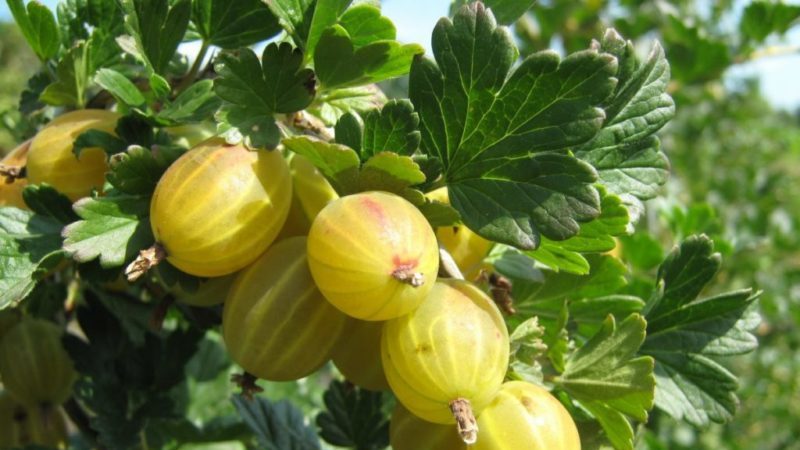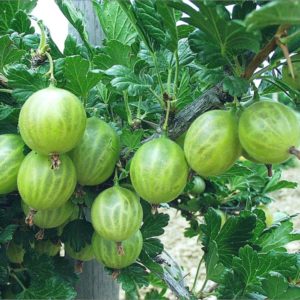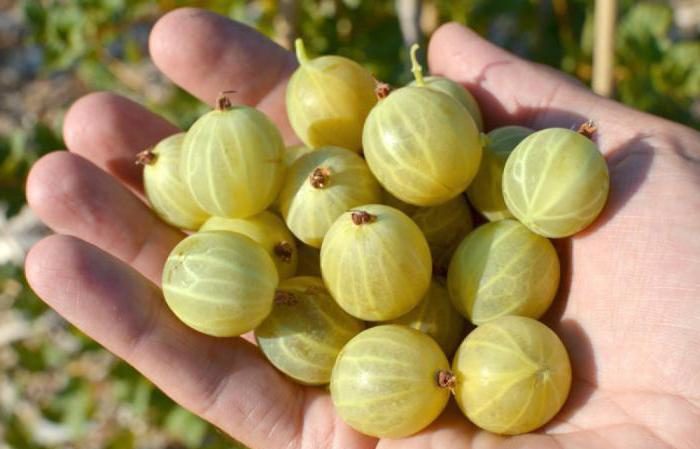Description of the gooseberry variety Beryl: pros and cons, care features
Beryl is a winter-hardy gooseberry variety intended for cultivation in harsh climatic conditions. Gained popularity due to its unpretentiousness, yield and taste of berries. We give a detailed description of the Beryl gooseberry variety and talk about the agricultural technology of this fruit bush.
The content of the article
What is this gooseberry variety
The gooseberry variety Beryl was developed in the 70s. XX century in the South Ural Research Institute as a result of crossing the varieties Malachite and Nugget. The author of the development was Dr. Ilyin. The culture was introduced into the State Register of the Russian Federation in 1998, after which the variety was zoned in the Ural and West Siberian regions.

Characteristics and description of the bushes
Gooseberry bushes are characterized by an average height (up to 1 m) and moderate crown spreading. The lower part of the shoots is covered with weak single thorns directed downwards, which makes harvesting easier. Large green leaves have a smooth surface. The gooseberry bears fruit actively for 5 years after planting.
Reference. The yield is from 8 to 10 kg of berries per bush.
Withstands temperature drops down to -38 ° C, as well as small periods of drought. Does not like excessive moisture. It has good immunity, is resistant to powdery mildew and fruit rot, but is often exposed to septoria.
Characteristics and description of fruits
Beryl's light green berries are spherical. Their weight reaches 9 g. The skin is thin, but strong, the pulp is juicy. The taste is sweet with a slight sourness. The fruits tolerate transportation well without losing their presentation. Berries are used both in their natural form and for the production of desserts, sauces, marinades, and alcoholic beverages. Traditional medicine uses gooseberries as the main component of medicinal drugs. The fruits are also used in cosmetology for the manufacture of creams, scrubs, masks, lotions.
Advantages and disadvantages of the variety
Among the advantages of the variety are:
- frost resistance;

- ability to withstand short-term drought;
- consistently high yield and excellent fruit taste;
- powdery mildew resistance;
- features of the arrangement of thorns, as well as their small number;
- self-fertility;
- good transportability during the period of technical ripeness;
- versatility of using berries;
The disadvantages of the variety are called:
- predisposition to septoria;
- the risk of injury by sawflies;
- decrease in yield in case of violation of agricultural technology;
- poor keeping quality of ripe berries.
Growing technology
Gooseberry Beryl grows on soils with good moisture and air permeability (clay and loamy, sandy and sandy loam) with a moderate level of acidity (4.6-5.0 pH). Does not like swampy soils with a close occurrence of groundwater. For planting, choose an area illuminated by the sun and protected from drafts. Shrub care consists of standard procedures: watering, feeding, pruning, prevention of damage diseases and pests.
Attention! The most comfortable for gooseberries are the aisles of trees planted in sunlit heights.
Terms and rules of landing
Gooseberries are planted both in early spring after thawing and warming up of the soil, and in autumn, in September - October, 2-3 weeks before the start of frost. When planting a shrub, adhere to the following sequence:
- Planting pits are prepared with a size of 40x40x40 cm.
- Holes in a row are placed at intervals of 1.5 m, and adjacent rows are at a distance of 2 m from each other.
- To fill the planting pit, a soil mixture is prepared from ordinary soil, a bucket of rotted manure, 1 tbsp. wood ash, 30 g of superphosphate and 20 g of potassium phosphate.
- Before planting, the tops of the shoots are cut off a little, the roots are shortened and process a root formation stimulant.
- A small amount of the prepared substrate is poured into the planting hole, forming a mound from it.
- The seedling is placed on a dais, carefully spreading the roots along the slopes.
- Fill the voids with soil mixture, lightly tamping each layer.
- The plantings are watered and covered with natural mulch (straw, sawdust, dry foliage or rotted manure).
Further care consists in watering, feeding, pruning and combating pests.
Watering
Regular watering is important during budding, flowering, and also during the active phase of fruit development. Therefore, gooseberries are watered at the root at least 1 time per week at the rate of 1 bucket of water for each bush. At the same time, they try to protect the leaves and shoots from falling drops. Each procedure is followed by loosening of the soil while removing weeds.
Important! 2 weeks before the start of harvesting, soil moistening under the bushes is stopped.
Top dressing
To achieve high yields, they resort to feeding. At the end of spring, liquid fertilizers rich in nitrogen, mullein, chicken droppings, and urea are introduced into the soil. At the end of flowering, in June, fertilizing is carried out with potassium-phosphorus fertilizers, adding 20 g of potassium phosphate or 30 g of superphosphate under each bush. In the first half of July, the soil under the gooseberry is spilled with magnesium nitrate at the rate of 20 g of the substance per bucket of water. In the fall, the bushes are again fed with phosphorus-potassium fertilizer in the same dosage as in the summer.
Pruning
Every year, in early spring, gooseberries are sanitized. Removing dry, diseased and old shoots avoids thickening of plantings and weakening of plants, as well as chopping berries. Shoots of the current year are shortened by 1/3 of the length. Of the basal stems, only 4 of the strongest are left, the rest are cut out.
Read also:
An unpretentious gooseberry variety "Yarovaya".
Diseases and pests
Beryl variety is resistant to fruit rot and powdery mildew. However, with improper care, the likelihood of being affected by fungal diseases remains. So, with excessive moisture and thickening of the plantings, septoria occurs, manifested by spots on the leaves and shoots. The lesion site increases over time, forming a dense bloom, which leads to drying and leaf fall. Measures for the prevention of fungal diseases include:
- digging up the soil;
- thinning branches;
- fertilization;
- cleaning and destruction of fallen leaves;
- fungicide treatment.
Bushes are rarely affected by pests. The exception is sawflies, the larvae of which completely destroy all green parts of the plant. To combat pests, gooseberries are treated with a Bordeaux mixture or ash and soap solution.
Wintering
For the successful wintering of gooseberries, preparatory work is carried out. After waiting for the foliage to fall, they rake and destroy all plant residues. The soil is dug up, the weeds are removed. The trunks are loosened, at the same time embedding phosphorus-potassium fertilizing into the soil. Trunks older than 5 years are cut. To ensure a podzimny moisture charge, the soil under each bush is spilled with 5-6 buckets of water. Young plants are bent to the ground and pinned with pegs. The soil around the plant is mulched with humus.
Features of cultivation depending on the region
The peculiarities of growing gooseberries are determined by the climatic characteristics of a particular region. So, in the Urals and Western Siberia, the shrub is planted only in the spring after the soil warms up.In the southern regions, planting is carried out even in October. In Siberia, the culture winters well only under the snow, while in the south of Russia additional shelter is not required.
Reproduction
Gooseberry Beryl is propagated by layering and cuttings. In the first case, young shoots are bent to the ground and laid horizontally, after which they are sprinkled with soil. After the sprouts appear, they are spud and watered. With the arrival of autumn, the branch is cut off from the bush, dug up and divided into parts. Each resulting seedling is moved to a permanent place of growth.
For reproduction strong young shoots are selected by cuttings. The branches are divided into parts so that each of them bears 4 buds. The stalk is deepened into loose fertile soil, leaving a section with one bud above the surface. With the arrival of winter, it is sheltered, and in the spring, further cultivation is continued, leaving 2 developed buds and moistening the soil as needed. The next spring, the seedling is determined for a permanent place of growth.
Reviews of summer residents

Beryl gained the greatest popularity among summer residents from regions of risky farming. Here are a few reviews.
Alexander, Chelyabinsk: “The variety pleased me with its yield and excellent taste. When harvesting, I did not feel pricks of thorns. But the branches tend to spread out on the ground, so you can't do without a support. "
Antonina, Tyumen: “The gooseberries are fully ripe in the short northern summer. The berries are sweet and aromatic. Some were eaten in their natural form, the rest were sent to fruit compotes and jam. "
Igor, Yekaterinburg: “Every spring I process the bushes with copper sulfate and cut off old branches. The gooseberry never got sick. I advise everyone not to save space and stick to the required distance between the bushes. "
Conclusion
Gooseberry Beryl is intended for growing in temperate and cold climates. With proper agricultural technology, it bears fruit in one place for 10 years. Gives a stable yield with high taste characteristics. Resistant to powdery mildew and fruit rot. It successfully overwinters without additional shelter. Easy to reproduce. Suitable for both home and industrial cultivation.